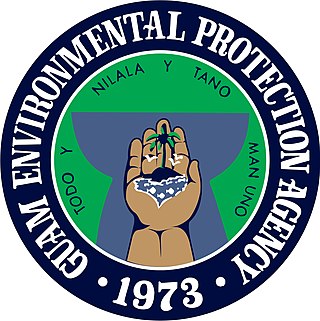Related Research Articles

Polychlorinated biphenyls (PCBs) are highly carcinogenic chemical compounds, formerly used in industrial and consumer products, whose production was banned in the United States by the Toxic Substances Control Act in 1979 and internationally by the Stockholm Convention on Persistent Organic Pollutants in 2001. They are organic chlorine compounds with the formula C12H10−xClx; they were once widely used in the manufacture of carbonless copy paper, as heat transfer fluids, and as dielectric and coolant fluids for electrical equipment.
Roundup is the brand name of a systemic, broad-spectrum glyphosate-based herbicide originally produced by Monsanto, which Bayer acquired in 2018. Glyphosate is the most widely used herbicide in the United States. As of 2009, sales of Roundup herbicides still represented about 10 percent of Monsanto's revenue despite competition from Chinese producers of other glyphosate-based herbicides. The overall Roundup line of products, which includes genetically modified seeds, represented about half of Monsanto's yearly revenue. The product is marketed to consumers by Scotts Miracle-Gro Company.

Glyphosate is a broad-spectrum systemic herbicide and crop desiccant. It is an organophosphorus compound, specifically a phosphonate, which acts by inhibiting the plant enzyme 5-enolpyruvylshikimate-3-phosphate synthase. It is used to kill weeds, especially annual broadleaf weeds and grasses that compete with crops. Its herbicidal effectiveness was discovered by Monsanto chemist John E. Franz in 1970. Monsanto brought it to market for agricultural use in 1974 under the trade name Roundup. Monsanto's last commercially relevant United States patent expired in 2000.

The Dow Chemical Company, officially Dow Inc., is an American multinational chemical corporation headquartered in Midland, Michigan, United States. The company is among the three largest chemical producers in the world.

The Federal Insecticide, Fungicide, and Rodenticide Act (FIFRA) is a United States federal law that set up the basic U.S. system of pesticide regulation to protect applicators, consumers, and the environment. It is administered and regulated by the United States Environmental Protection Agency (EPA) and the appropriate environmental agencies of the respective states. FIFRA has undergone several important amendments since its inception. A significant revision in 1972 by the Federal Environmental Pesticide Control Act (FEPCA) and several others have expanded EPA's present authority to oversee the sales and use of pesticides with emphasis on the preservation of human health and protection of the environment by "(1) strengthening the registration process by shifting the burden of proof to the chemical manufacturer, (2) enforcing compliance against banned and unregistered products, and (3) promulgating the regulatory framework missing from the original law".
A Biopesticide is a biological substance or organism that damages, kills, or repels organisms seens as pests. Biological pest management intervention involves predatory, parasitic, or chemical relationships.
In the experimental (non-clinical) research arena, good laboratory practice or GLP is a quality system of management controls for research laboratories and organizations to ensure the uniformity, consistency, reliability, reproducibility, quality, and integrity of products in development for human or animal health through non-clinical safety tests; from physio-chemical properties through acute to chronic toxicity tests.

Dicamba is a broad-spectrum herbicide first registered in 1967. Brand names for formulations of this herbicide include Dianat, Banvel, Diablo, Oracle and Vanquish. This chemical compound is a chlorinated derivative of o-anisic acid.

The Food Quality Protection Act (FQPA), or H.R.1627, was passed unanimously by Congress in 1996 and was signed into law by President Bill Clinton on August 3, 1996. The FQPA standardized the way the Environmental Protection Agency (EPA) would manage the use of pesticides and amended the Federal Insecticide, Fungicide, and Rodenticide Act and the Federal Food Drug and Cosmetic Act. It mandated a health-based standard for pesticides used in foods, provided special protections for babies and infants, streamlined the approval of safe pesticides, established incentives for the creation of safer pesticides, and required that pesticide registrations remain current.

Water testing is a broad description for various procedures used to analyze water quality. Millions of water quality tests are carried out daily to fulfill regulatory requirements and to maintain safety.

Clothianidin is an insecticide developed by Takeda Chemical Industries and Bayer AG. Similar to thiamethoxam and imidacloprid, it is a neonicotinoid. Neonicotinoids are a class of insecticides that are chemically similar to nicotine, which has been used as a pesticide since the late 1700s. Clothianidin and other neonicotinoids act on the central nervous system of insects as an agonist of nAChR, the same receptor as acetylcholine, the neurotransmitter that stimulates and activating post-synaptic acetylcholine receptors but not inhibiting AChE. Clothianidin and other neonicotinoids were developed to last longer than nicotine, which is more toxic and which breaks down too quickly in the environment. However, studies published in 2012 show that neonicotinoid dust released at planting time may persist in nearby fields for several years and be taken up into non-target plants, which are then foraged by bees and other insects.

The Guam Environmental Protection Agency is a government agency of the United States territory of Guam.

Pesticide regulation in the United States is primarily a responsibility of the Environmental Protection Agency (EPA). In America, it was not till the 1950s that pesticides were regulated in terms of their safety. The Pesticides Control Amendment (PCA) of 1954 was the first time Congress passed guidance regarding the establishment of safe limits for pesticide residues on food. It authorized the Food and Drug Administration (FDA) to ban pesticides they determined to be unsafe if they were sprayed directly on food. The Food Additives Amendment, which included the Delaney Clause, prohibited the pesticide residues from any carcinogenic pesticides in processed food. In 1959, pesticides were required to be registered.
Industrial Bio-Test Laboratories was an American industrial product safety testing laboratory. IBT conducted significant quantities of research for pharmaceutical companies, chemical manufacturers and other industrial clients; at its height during the 1950s, 1960s, and 1970s, IBT operated the largest facility of its kind and performed more than one-third of all toxicology testing in the United States. IBT was later confirmed of engaging in extensive scientific misconduct, or more properly, fraud, which resulted in the indictment of its president and several top executives in 1981 and convictions in 1983. The revelations of misconduct by IBT Labs led to reforms in the regulation of pesticides in the United States and Canada.
The Séralini affair was the controversy surrounding the publication, retraction, and republication of a journal article by French molecular biologist Gilles-Éric Séralini. First published by Food and Chemical Toxicology in September 2012, the article presented a two-year feeding study in rats, and reported an increase in tumors among rats fed genetically modified corn and the herbicide RoundUp. Scientists and regulatory agencies subsequently concluded that the study's design was flawed and its findings unsubstantiated. A chief criticism was that each part of the study had too few rats to obtain statistically useful data, particularly because the strain of rat used, Sprague Dawley, develops tumors at a high rate over its lifetime.
Monsanto was involved in several high-profile lawsuits, as both plaintiff and defendant. It had been defendant in a number of lawsuits over health and environmental issues related to its products. Monsanto also made frequent use of the courts to defend its patents, particularly in the area of agricultural biotechnology.

The Circle of Poison (COP) refers to the export of domestically banned pesticides for use on foods elsewhere, some of which returns by way of import. The "circle" is complete when the toxic chemicals that were exported are then used to grow fruit, meat, and produce that are imported and available for domestic consumption. This circle was first identified relative to the United States but the relationship also exists between other nations of the Global North and South.
Cannabis product testing is a form of product testing analyzes the quality of cannabis extracts, edibles, and THC and CBD levels in an emergent consumer market eager to sell adult use products. Analytical chemistry and microbiology laboratories are important entities in consumer protection. These labs not only determine the condition and viability of cannabinoids, water content, heavy metals, pesticides, terpenes, yeast, but also the presence of mold, mycotoxins, and solvents. These laboratories emerged when advocates of cannabis testing raised concerns about potential contaminants.
Glyphosate-based herbicides are usually made of a glyphosate salt that is combined with other ingredients that are needed to stabilize the herbicide formula and allow penetration into plants. The glyphosate-based herbicide Roundup was first developed by Monsanto in the 1970s. It is used most heavily on corn, soy, and cotton crops that have been genetically modified to be resistant to the herbicide. Some products include two active ingredients, such as Enlist Duo which includes 2,4-D as well as glyphosate. As of 2010, more than 750 glyphosate products were on the market. The names of inert ingredients used in glyphosate formulations are usually not listed on the product labels.
Carol Van Strum is an American environmental activist who since 1975 has fought against the spraying of pesticides, including Agent Orange, in the Siuslaw National Forest in Oregon. Her subsequent research, including over 20,000 documents revealing corporate and government cover-ups, was donated to the Poison Papers project in 2017. In 2018, Van Strum received the David Brower Lifetime Achievement Award for her contributions to forestry policy favoring selective harvest without the use of herbicides.
References
- ↑ Jensen, Carl (1997). "Fraudulent Safety Tests Deceive the American People". 20 Years of Censored News . Seven Stories Press. pp. 125. ISBN 978-1888363524.
- 1 2 Novak, Roger A. (2001). "The long arm of the lab laws". Today's Chemist at Work. 10 (11). Retrieved 2015-12-01.
- ↑ Collier, Bill (1991-03-02). "EPA studies allegations Austin lab faked pesticide data". The Austin American-Statesman.
- ↑ "Austin Lab, president indicted in federal pesticide testing case". The Victoria Advocate . 1992-09-30. Retrieved 2015-12-01.
- ↑ "EPA FY1994 Enforcement and Compliance Assurance Accomplishments Report" (PDF). United States Environmental Protection Agency.
- 1 2 Frederikson, Tim (March 1993). "Pesticide Safety Fraud". New Zealand Science Monthly. Retrieved 2015-12-01.
- ↑ "Texas firm probed for residue studies". Moscow-Pullman Daily News . 1991-03-01. Retrieved 2015-12-01.
- ↑ MacCormack, Zeke (1993-12-05). "Craven Laboratories owner pleads guilty: Craven made false statements to EPA about pesticide tests". The Austin American-Statesman.
In accepting the plea agreement Thursday, four days into his trial, Craven became the 15th employee of Craven Laboratories Inc. to admit guilt in what prosecutors have called the most significant environmental case in Central Texas history.
- ↑ "Backgrounder: Testing Fraud: IBT and Craven Laboratories" (PDF). Monsanto. June 2005. Archived from the original (PDF) on 2012-10-30. Retrieved 2012-07-11.
- ↑ "Testing Fraud: IBT and Craven Labs" (PDF). Backgrounder. Monsanto Company. June 2005. Archived from the original (PDF) on 2012-10-30. Retrieved 2012-07-12.